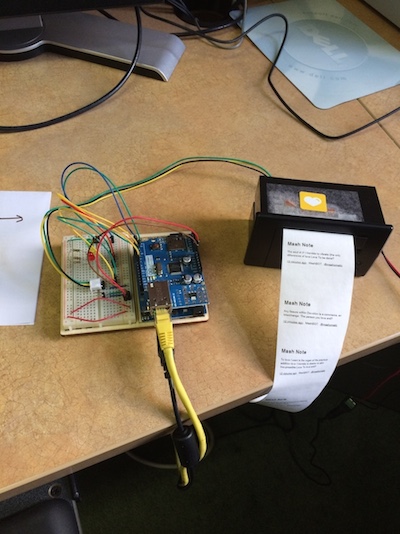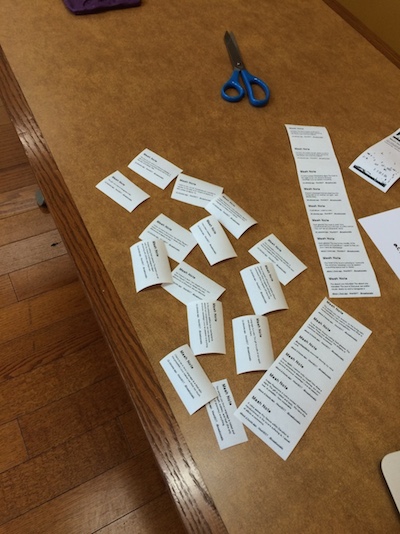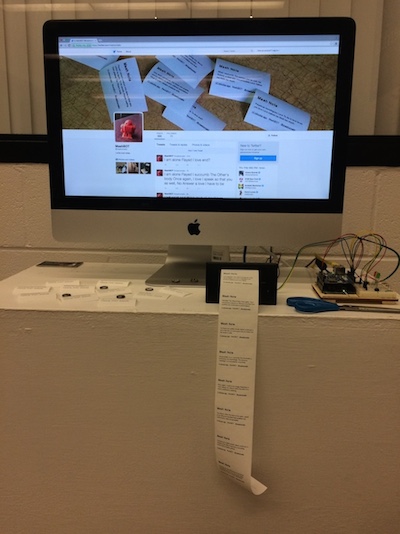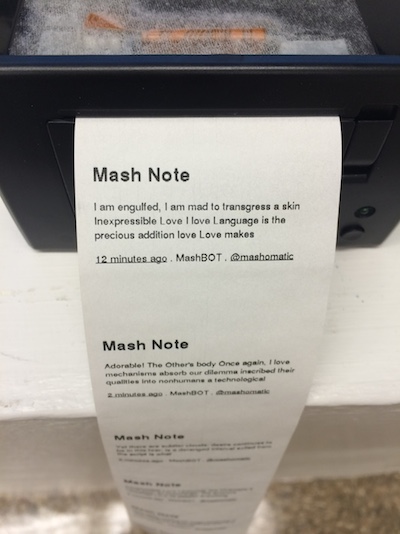Mashbot kit index
Love Notes and Intimate Circuits
Helen J. Burgess
North Carolina State University
 Critical Essay: Making Love in the Mangle of Practice
Critical Essay: Making Love in the Mangle of Practice
MashBOT is a physical computing project originally built for exhibit at the 2015 Babel Biennale in Toronto, a meeting of medievalists, book scholars and artists. The conference theme was "Off the Books: Making, Breaking, Binding, Burning, Leaving, Gathering" — calling for projects and papers to
consider what it means to go 'off the books': how ideas and various cultural and historical forms leap off from and out of books; how we ourselves are 'off of' books and 'over' books; what it means to go 'off the books' or 'off the record': to go astray, between and off the lines, underground, and illegal, and to be unaccounted for."
My scholarly compatriot Craig Saper and I proposed a session on love notes. The session was originally conceived as a "mash note" (love note, with overtones of "crush") to Eileen Joy and Punctum Books, with whom Craig and I were proposing a publishing affiliation for a new imprint called Electric Press. (Eileen herself calls the act of publishing "the pressing 'crush' of the crowd into the commons," which is one of many reasons we love her. ) Mash, from the romani for "entice," seemed an appropriate tone to take: it was an outpouring of desire for connection with a press that promises to "solicit and pimp quixotic, sagely mad engagements with textual thought-bodies." Thus the session was meant as a kind of enticing space to accompany what is simultaneously a business proposal (although not a pecuniary one) and a proposal of love — love for what we do and an offer to extend that love to others seeking to publish their work. Thus, our call for contributors:
We have long participated in signed or anonymous declarations of love and desire. Even in our neoliberal institutions, peculiarly bloodless forms remain: the corporate pitch meeting, the grant proposal warped by our understanding of what the other (funding agencies) wants. Screw that. As Roland Barthes declares, What love lays bare in me is energy. This will be an online/offline un-session conducted in a physical installation space, featuring participants entering into the lover's discourse, with documents both electrical and tactile.
MashBOT, my own contribution, was one of four artefacts that ended up on display in the University of Toronto Center for Medieval Studies' Great Hall. The others spanned the range of media interpretations of love: a hand-pressed book of original poetry to a deceased parent; a video slideshow of architectural and theoretical readings, and a podcast on the love of academic life. MashBOT is a technological assemblage consisting of a Twitter account, a network-connected microcontroller, and a thermal receipt printer. The project mashes together short phrases from a preexisting corpus of text to create new lines, tweets them, and then prints that tweet on thermal paper. After a few bumpy starts dealing with the University of Toronto's network security system, the printer occupied a small room to one side of the Great Hall, whence issued a steady stream (or ticker tape, as the case may be) of love notes.


The love notes were expressive of a network of desire, and the way that desire circulated in MashBOT was evident from the very beginning. Roland Barthes' book A Lover's Discourse, which acts as a kind of touchstone for Electric Press' own credo, became an obvious corpus from which to work. In my role as a lover of machines and actor-network-theory, I also leavened the corpus with 10% quotes from Bruno Latour's Aramis, Or, Love of Technology: a book about the failure of a personal rapid transit system in Paris. Kyle McGee, writing on Aramis, notes that "technological seduction is always a risky courtship," observing that,
No technical object, it is true, will be enamored of the engineer that whispers sweet nothings into its sockets; to solicit its assistance is, however to do right by it and respect its protocols. What is called technical proficiency is a human actant's mastery of such protocols — surely a kind of human-nonhuman love, premised on the human's deep respect for the nonhuman's constraints and demands.
Latour's book ended by arguing that the failure of the Paris rapid transit system stemmed from the fact that the project was "unloved." This would not happen to MashBOT, I vowed. I wanted this little machine to flourish (it did), just as I wanted our new publishing venture to flourish (it does). Getting this thing running became an index of my own desire to not fuck it all up.

Mashing and Mangling
MashBOT prints tweets. That doesn't sound too difficult to create — in fact, you can go to Adafruit or Sparkfun and find an "Internet of Things" kit to thermal print online material. I'd had one of these kits kicking around unopened for about a year while I tried to figure out what I wanted to do with it. And yet as soon as I'd conceptualized MashBOT, I was instantly stymied by the fact that the kit was already out of date: Twitter had recently changed its security authentication and the Arduino code used to connect with a Twitter account no longer worked. This initial stumbling block was followed by a firmware update that had rendered a whole generation of thermal printers inoperable via Arduino. Raspberry Pi seemed like an alternative, but I didn't really want to shell out for another whole kit and learn how to put together another whole system in under a week. Overnight shipping is just too expensive. So, foolishly, I decided to hack it all together from a range of sources. The Twitterbot, it turned out, was the easiest part of the project to make: I used Zach Whalen's excellent and easy-to-configure Google Spreadsheets "Markov" script. Outside of Twitter, though, a monstrous chain of cobbled together technologies began to compile itself, made up of the printer and Arduino microcontroller, the original thermal printer firmware, a backend server system called "exciting.io" that was used to send material from a web page to a printer, a PHP script for logging in to the Twitter authentication system correctly and displaying the very latest tweet, and a simple cron job that would run every 15 minutes, linking Twitter — to page — to backend server — to Arduino — to printer. Somewhere in amongst all those connections dwelt MashBOT, like a slightly creepy Gibsonian Legba.
Clearly there are more efficient ways to do this, but by the time I was done with it, I was caught up in the joy of what Andrew Pickering calls "the mangle of practice" — the performativity of working with technology that is, like science, "an evolving field of human and material agencies reciprocally engaged in the play of resistance and accommodation." Every added link in MashBOT's technological chain was a result of a workaround for a temporary lapse in communication between software, hardware, service (and me). The whole thing was ugly, like a stitched together Frankenstein. But there was a little button to press and a mash note came out. What's not to love?
Two Desiring Machines
MashBOT, as an artifact made up of 99% other peoples' technologies and my own 1% steely-eyed nerve in the face of pesky TSA baggage inspectors, is still very much a work in progress: more of a prototype than a finished product. I'm aware of my own desires in this venture: to create something that is "electric" — something that can evoke a loving response. But as a scholar I find myself mired in the myths of "originality" — I didn't make up the idea of printing from Twitter onto a thermal printer. I didn't create a whole back end out of nothing. I didn't even write my own Markov script. Everything was built out of preexisting materials. I just figured out how to chain together and configure this increasingly long series of balky components. And yet, there's no mistaking that MashBOT is meaningful, even if only by serendipitous configuration. Liza Blake, speaking at the very end of the closing plenary session at Babel, ended her statements by reading out a tweet from MashBOT, which she'd picked up at some stage during Sunday's display. "He wrote it just for me," she said.
I'm already planning his next incarnation. From my perspective, what I want for MashBOT is to have him be more easily portable (so I don't have to run around finding wired power and network access points), be less "prototype"-looking (so I can be taken more seriously as a "maker," maybe? I don't really know), and have less potential points of failure (so I'm not reliant on multiple third-party services, any one of which could go down or be upgraded at any time). In short, I want him to be less "mashy." Clearly the easiest way to do this will be to start removing links in the chain: get a driver that can go straight from twitter to the printer via Raspberry Pi or some such. Strip it all down. Make it efficient. From MashBOT's plane of view, these same desires start to look weirdly human-analog: Access to energy. Access to a reliable communication channel. And, in a machinic-libertarian push for autonomy, less reliance on others for survival.
My wavering over the aesthetic "look" of MashBOT, though, says much more about my sense of myself in the network than it does about the needs of the machine. For a start, there's the double eye that comes from being an editor. In this capacity, I spend a lot of time trying to polish works up and help authors put on the "best face" for publication. But as a scholar, I spend my time digging into the back ends of things, pulling them apart, trying to figure out what makes them tick - and trying to communicate how important the underside of things are; what N. Katherine Hayles characterizes as a tension between "practices of concealing and revealing." Am I supposed to be concealing the mechanism, like a consumer product developer or a publisher putting a bright skin on a finished article; or am I supposed to be revealing those same things, to show what the mechanism looks like "stripped bare," as any good scholar should do? And where does the "maker aesthetic" of Arduino boards and wires fit in: does showing those components make me look more makerly (is the Arduino board the hipster fixie of the academic maker set)? In short, to quote Lucy Suchman, "Is this order, or mess?"
These questions of aesthetic and appearance, along with my qualms about my own "originality," are part and parcel, I think, of the questions of "legitimacy" that are endemic to our understandings of what scholarship is and how it is performed. We can be makers, but only amateurs. Our scholarship is often evaluated in terms of the writing about what we make, not the making itself. And so the secret mangle of practice that is writing itself must be made smooth, so that no one can see the negotiations, the compromises, the moments we sell out, the moments we fall in sweaty love.
As I write this, MashBOT is sitting several state lines away on a white gallery platform in the Rutgers-Camden Digital Studies Center. I get lonely emails from my cron server every couple of hours as a new tweet is sent to his SIM card, stored until a passerby presses the button. As such, he's a hybrid between a purely functional object and a communicative creature. MashBOT crosses the line, and goes "off the books", but though he is a little machine hooked up to a giant corporate network, he is still a writer. And he can still say things like this:
To be invented here is what I knew no desire continues to me, cut off, thunderstruck I want is to wander In the dark interior@mashomatic 6:02 AM — 4 Nov 2015
Me too, MashBOT. Me too.

Notes
- Babel Working Group, "CFP: 2015 Meeting 4th Biennial Meeting of the BABEL Working Group." 2015. «http://babel-meeting.org/2015-meeting/»
- Eileen Joy, "Let Us Now Stand Up for Bastards." In The Middle, 2015. «http://www.inthemedievalmiddle.com/2015/02/let-us-now-stand-up-for-bastards.html»
- Punctum Books, "Credo." Punctum Books, 2015. «http://punctumbooks.com»
- Helen J Burgess and Craig Saper, "CFP: Mash Notes." Electric Press, 2015. «http://electric.press/mash/».
- Kyle McGee, Bruno Latour: The Normativity of Networks. London: Routledge, 2013. 63.
- Andrew Pickering, "The Mangle of Practice: Agency and Emergence in the Sociology of Science." American Journal of Sociology Vol. 99, No. 3 (Nov., 1993): 559-589. 567.
- N. Katherine Hayles, My Mother Was a Computer: Digital Subjects and Literary Texts. Chicago: University of Chicago Press, 2005. 54.
- Lucy Suchman, "Practice and its Overflows: Reflections on Order and Mess." Technoscienza: Italian Journal of Science and Technology Studies Vol 2, No.1 (2011): 21-30. 28.